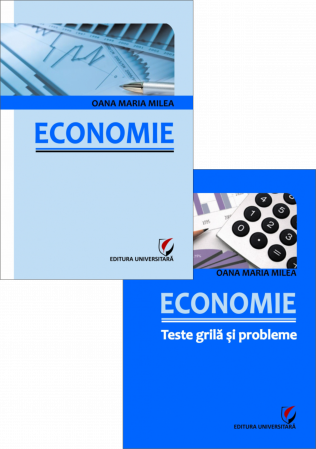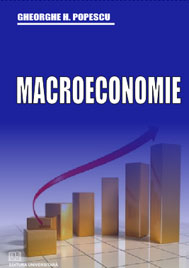Manuscript proposals: info@editurauniversitara.ro / 0745 204 115 //// Tracking orders Individuals / Sales:0745 200 718 / 0745 200 357 Orders Legal entities: 0721 722 783
ISBN: 978-606-591-683-8
DOI: 10.5682/9786065916838
Publisher year: 2013
Edition: I
Pages: 106
Publisher: Editura Universitara
Author: Basarab Gogoneata
Product Code:
9786065916838
Do you need help?
0745 200 718
/
0745 200 357
- Description
- Download (1)
- Authors
- Content
- More details
- Where to find it
- Reviews (0)
In any economy can be discovered a huge number of situations affected by information asymmetry. Romania's economy is no exception. It would be impossible to treat even a small part of them exhaustively. This was never the intention of this paper which aims to analyze only a few examples, highlighting the explanation of theoretical concepts. The common feature of the selected examples is their great importance for economics and relevance for understanding the effects of information asymmetry.
The first chapter introduces the structural elements of information asymmetry analysis models. The Anglo-Saxon language established the models based on two players, one being Principal and the other Agent. The first is the one who delegates to the second the performance of economic activities in conditions of informational asymmetry. In order to avoid any confusion, in this chapter the most suitable translation in Romanian, that of Mandant and Mandatar, is widely discussed. The legal origin of these terms may impose restrictions, so there is a broad discussion of the differences between the legal and economic approach. The clarification of this terminological differentiation allows the use of the two terms in all the subsequent chapters that aim at the concrete modeling of some situations of manifestation of the effects of the informational asymmetry in the Romanian economy.
The second chapter is dedicated to moral hazard. In English the term is moral hazard, which complicates the translation into Romanian, because both the term risk and the hazard can be used. Chance, even if it is less commonly used in everyday speech, is related to gambling and the risk-taking attitude (gambling), which is very close to the essence of moral hazard behavior. The concept of moral hazard is not wrong either because it also reflects a danger caused by information asymmetry. Moral hazard occurs when under the protection of an informational advantage the actions of an economic subject become more risky and / or less ethical. A much-discussed example internationally is that of managers in the banking sector who have aggressively credited non-performing sectors of the world economy, anticipating that they will not be personally liable for losses. For Romania, we chose as representative the decision to use the monetary issue to finance the budget deficit in the period 1990-2004. The political powers of that period felt protected by the dissatisfaction of the population because inflation is a complex phenomenon and its monetary causes can be relatively easily concealed. .
The third chapter deals with the adverse selection that occurs when choices are affected by information asymmetry. The selection turns against the one who makes it, because the decision maker does not have all the necessary information. In an extreme case, the choice becomes almost impossible because the information asymmetry affects both the decision maker and the economic subjects subject to selection, taking place a process of worsening their quality, because opacity attracts negative elements. Adverse selection profoundly affects the balance of the markets.
The first chapter introduces the structural elements of information asymmetry analysis models. The Anglo-Saxon language established the models based on two players, one being Principal and the other Agent. The first is the one who delegates to the second the performance of economic activities in conditions of informational asymmetry. In order to avoid any confusion, in this chapter the most suitable translation in Romanian, that of Mandant and Mandatar, is widely discussed. The legal origin of these terms may impose restrictions, so there is a broad discussion of the differences between the legal and economic approach. The clarification of this terminological differentiation allows the use of the two terms in all the subsequent chapters that aim at the concrete modeling of some situations of manifestation of the effects of the informational asymmetry in the Romanian economy.
The second chapter is dedicated to moral hazard. In English the term is moral hazard, which complicates the translation into Romanian, because both the term risk and the hazard can be used. Chance, even if it is less commonly used in everyday speech, is related to gambling and the risk-taking attitude (gambling), which is very close to the essence of moral hazard behavior. The concept of moral hazard is not wrong either because it also reflects a danger caused by information asymmetry. Moral hazard occurs when under the protection of an informational advantage the actions of an economic subject become more risky and / or less ethical. A much-discussed example internationally is that of managers in the banking sector who have aggressively credited non-performing sectors of the world economy, anticipating that they will not be personally liable for losses. For Romania, we chose as representative the decision to use the monetary issue to finance the budget deficit in the period 1990-2004. The political powers of that period felt protected by the dissatisfaction of the population because inflation is a complex phenomenon and its monetary causes can be relatively easily concealed. .
The third chapter deals with the adverse selection that occurs when choices are affected by information asymmetry. The selection turns against the one who makes it, because the decision maker does not have all the necessary information. In an extreme case, the choice becomes almost impossible because the information asymmetry affects both the decision maker and the economic subjects subject to selection, taking place a process of worsening their quality, because opacity attracts negative elements. Adverse selection profoundly affects the balance of the markets.
-
Efectele asimetriei informationale in economia Romaniei
Download
BASARAB GOGONEATA
Introduction / 7
Chapter 1. Mandatory model (principal) - agent (agent) in the study of information asymmetry / 12
1.1. The concept of informational asymmetry / 12
1.2. The framework for defining the key concepts used in the study of information asymmetry / 14
Chapter 2. Moral hazard / 22
2.1. Modeling situations with moral hazard / 22
2.2. Galloping inflation in Romania during 1991-2004 and the provisions of the BNR / 26 statute
Chapter 3. Adverse selection / 36
3.1. Basics of modeling adverse selection situations / 36
3.2. Adverse selection on the Romanian insurance market / 38
3.3. Market equilibrium with asymmetric information: the “lemons” model / 44
3.3.1. Akerlof's model / 44
3.3.2. Wilson's model / 45
3.4. Adverse selection on the Romanian housing market / 48
3.4.1. The evolution of the market balance before and after Boom / 48
3.4.2. Analysis of the urban housing market in Romania based on Wilson / 53's model
3.4.3. The effects of the "First House" program / 59
Chapter 4. Signaling / 67
4.1. Fundamental elements in signaling theory / 67
4.2. Signaling through the higher education diploma in Romania / 71
4.2.1. Signaling on the labor market for higher education graduates / 71
4.2.2. The situation of higher education in Romania / 76
4.3. Signaling on the Romanian labor market with the help of the ERASMUS / 82 program
4.4. International labor force signaling and migration / 92
Conclusions / 99
Bibliography / 105
Chapter 1. Mandatory model (principal) - agent (agent) in the study of information asymmetry / 12
1.1. The concept of informational asymmetry / 12
1.2. The framework for defining the key concepts used in the study of information asymmetry / 14
Chapter 2. Moral hazard / 22
2.1. Modeling situations with moral hazard / 22
2.2. Galloping inflation in Romania during 1991-2004 and the provisions of the BNR / 26 statute
Chapter 3. Adverse selection / 36
3.1. Basics of modeling adverse selection situations / 36
3.2. Adverse selection on the Romanian insurance market / 38
3.3. Market equilibrium with asymmetric information: the “lemons” model / 44
3.3.1. Akerlof's model / 44
3.3.2. Wilson's model / 45
3.4. Adverse selection on the Romanian housing market / 48
3.4.1. The evolution of the market balance before and after Boom / 48
3.4.2. Analysis of the urban housing market in Romania based on Wilson / 53's model
3.4.3. The effects of the "First House" program / 59
Chapter 4. Signaling / 67
4.1. Fundamental elements in signaling theory / 67
4.2. Signaling through the higher education diploma in Romania / 71
4.2.1. Signaling on the labor market for higher education graduates / 71
4.2.2. The situation of higher education in Romania / 76
4.3. Signaling on the Romanian labor market with the help of the ERASMUS / 82 program
4.4. International labor force signaling and migration / 92
Conclusions / 99
Bibliography / 105
Information has now become an extremely valuable economic factor. All resource allocation decisions are based on forecasts and expectations that require a fast and quality information flow. But the information is hard to gain and is distributed unevenly.
It is this characteristic of the asymmetric distribution of information that underlies a vast number of economic phenomena. In the absence of a formal framework for analyzing information asymmetry, its effects can easily be confused and misinterpreted. For example, we can observe the non-functioning of a market.
Looking for explanations, we can accuse buyers of excessive pretensions, sellers of speculative behavior or simply prices of abnormal rigidity. In fact, the lack of market liquidity could be due to an asymmetrical distribution of information that makes buyers excessively cautious and causes some sellers to leave the market amid the frustration induced by buyers' behavior.
The development of an economy is inevitably accompanied by the extension and improvement of information circuits by increasing the degree of transparency and standardization. It is useless to discuss whether the reduction of information asymmetry supports economic development or vice versa because they actually go hand in hand. The most important thing is the correct diagnosis of the problems that information asymmetry can generate in the economy in order not to apply wrong treatments.
In any economy can be discovered a huge number of situations affected by information asymmetry. Romania's economy is no exception. It would be impossible to treat even a small part of them exhaustively. This was never the intention of this paper which aims to analyze only a few examples, highlighting the explanation of theoretical concepts. The common feature of the selected examples is their great importance for economics and relevance for understanding the effects of information asymmetry.
The first chapter introduces the structural elements of information asymmetry analysis models. The Anglo-Saxon language established the models based on two players, one being Principal and the other Agent. The first is the one who delegates to the second the performance of economic activities in conditions of informational asymmetry. In order to avoid any confusion, in this chapter the most suitable translation in Romanian, that of Mandant and Mandatar, is widely discussed. The legal origin of these terms may impose restrictions, so there is a broad discussion of the differences between the legal and economic approach. The clarification of this terminological differentiation allows the use of the two terms in all the subsequent chapters that aim at the concrete modeling of some situations of manifestation of the effects of the informational asymmetry in the Romanian economy.
The second chapter is dedicated to moral hazard. In English the term is moral hazard, which complicates the translation into Romanian, because both the term risk and the hazard can be used. Chance, even if it is less commonly used in everyday speech, is related to gambling and the risk-taking attitude (gambling), which is very close to the essence of moral hazard behavior. The concept of moral hazard is not wrong either because it also reflects a danger caused by information asymmetry. Moral hazard occurs when under the protection of an informational advantage the actions of an economic subject become more risky and / or less ethical. A much-discussed example internationally is that of managers in the banking sector who have aggressively credited non-performing sectors of the world economy, anticipating that they will not be personally liable for losses. For Romania, we chose as representative the decision to use the monetary issue to finance the budget deficit in the period 1990-2004. The political powers of that period felt protected by the dissatisfaction of the population because inflation is a complex phenomenon and its monetary causes can be relatively easily concealed. .
The third chapter deals with the adverse selection that occurs when choices are affected by information asymmetry. The selection turns against the one who makes it, because the decision maker does not have all the necessary information. In an extreme case, the choice becomes almost impossible because the information asymmetry affects both the decision maker and the economic subjects subject to selection, taking place a process of worsening their quality, because opacity attracts negative elements. Adverse selection profoundly affects the balance of the markets.
We will see how the optional car insurance sector in Romania is going through a very difficult period and must first of all improve not its sales force but its ability to establish a more precise risk profile of customers. Also in this chapter, the example related to the balance of the urban housing market proposes an explanation based on information asymmetry for the rapid growth rate of prices during the boom period 2005-2008. The adverse selection could manifest itself as a halo effect for buyers who perceived the high prices of new apartments as an indicator of their quality. Signaling is a phenomenon that occurs in conditions of information asymmetry and can contribute to a better functioning of economic activity. The subject with an informational advantage makes certain decisions that become a signal for other participants, in order to facilitate the conclusion of a contract. Education and international migration, two topical issues in Romania are analyzed to understand the effects of information asymmetry.
Decreasing the average quality of university studies in Romania reduces the average level of training of specialists but worsens the chances of employment and those graduates who study very well, because employers lose confidence in all diplomas.
The effects of the information asymmetry in the Romanian economy are ample and cannot be eliminated. But if we understand their logic and scope we will be able to take effective measures to mitigate them.
It is this characteristic of the asymmetric distribution of information that underlies a vast number of economic phenomena. In the absence of a formal framework for analyzing information asymmetry, its effects can easily be confused and misinterpreted. For example, we can observe the non-functioning of a market.
Looking for explanations, we can accuse buyers of excessive pretensions, sellers of speculative behavior or simply prices of abnormal rigidity. In fact, the lack of market liquidity could be due to an asymmetrical distribution of information that makes buyers excessively cautious and causes some sellers to leave the market amid the frustration induced by buyers' behavior.
The development of an economy is inevitably accompanied by the extension and improvement of information circuits by increasing the degree of transparency and standardization. It is useless to discuss whether the reduction of information asymmetry supports economic development or vice versa because they actually go hand in hand. The most important thing is the correct diagnosis of the problems that information asymmetry can generate in the economy in order not to apply wrong treatments.
In any economy can be discovered a huge number of situations affected by information asymmetry. Romania's economy is no exception. It would be impossible to treat even a small part of them exhaustively. This was never the intention of this paper which aims to analyze only a few examples, highlighting the explanation of theoretical concepts. The common feature of the selected examples is their great importance for economics and relevance for understanding the effects of information asymmetry.
The first chapter introduces the structural elements of information asymmetry analysis models. The Anglo-Saxon language established the models based on two players, one being Principal and the other Agent. The first is the one who delegates to the second the performance of economic activities in conditions of informational asymmetry. In order to avoid any confusion, in this chapter the most suitable translation in Romanian, that of Mandant and Mandatar, is widely discussed. The legal origin of these terms may impose restrictions, so there is a broad discussion of the differences between the legal and economic approach. The clarification of this terminological differentiation allows the use of the two terms in all the subsequent chapters that aim at the concrete modeling of some situations of manifestation of the effects of the informational asymmetry in the Romanian economy.
The second chapter is dedicated to moral hazard. In English the term is moral hazard, which complicates the translation into Romanian, because both the term risk and the hazard can be used. Chance, even if it is less commonly used in everyday speech, is related to gambling and the risk-taking attitude (gambling), which is very close to the essence of moral hazard behavior. The concept of moral hazard is not wrong either because it also reflects a danger caused by information asymmetry. Moral hazard occurs when under the protection of an informational advantage the actions of an economic subject become more risky and / or less ethical. A much-discussed example internationally is that of managers in the banking sector who have aggressively credited non-performing sectors of the world economy, anticipating that they will not be personally liable for losses. For Romania, we chose as representative the decision to use the monetary issue to finance the budget deficit in the period 1990-2004. The political powers of that period felt protected by the dissatisfaction of the population because inflation is a complex phenomenon and its monetary causes can be relatively easily concealed. .
The third chapter deals with the adverse selection that occurs when choices are affected by information asymmetry. The selection turns against the one who makes it, because the decision maker does not have all the necessary information. In an extreme case, the choice becomes almost impossible because the information asymmetry affects both the decision maker and the economic subjects subject to selection, taking place a process of worsening their quality, because opacity attracts negative elements. Adverse selection profoundly affects the balance of the markets.
We will see how the optional car insurance sector in Romania is going through a very difficult period and must first of all improve not its sales force but its ability to establish a more precise risk profile of customers. Also in this chapter, the example related to the balance of the urban housing market proposes an explanation based on information asymmetry for the rapid growth rate of prices during the boom period 2005-2008. The adverse selection could manifest itself as a halo effect for buyers who perceived the high prices of new apartments as an indicator of their quality. Signaling is a phenomenon that occurs in conditions of information asymmetry and can contribute to a better functioning of economic activity. The subject with an informational advantage makes certain decisions that become a signal for other participants, in order to facilitate the conclusion of a contract. Education and international migration, two topical issues in Romania are analyzed to understand the effects of information asymmetry.
Decreasing the average quality of university studies in Romania reduces the average level of training of specialists but worsens the chances of employment and those graduates who study very well, because employers lose confidence in all diplomas.
The effects of the information asymmetry in the Romanian economy are ample and cannot be eliminated. But if we understand their logic and scope we will be able to take effective measures to mitigate them.
www.editurauniversitara.ro
If you want to express your opinion about this product you can add a review.
write a review
Customer Support Monday - Friday, between 8.00 - 16.00
0745 200 718 0745 200 357 comenzi@editurauniversitara.ro
6359.png)
![The Effects of Information Asymmetry in the Romanian Economy [1] The Effects of Information Asymmetry in the Romanian Economy [1]](https://gomagcdn.ro/domains/editurauniversitara.ro/files/product/large/efectele-asimetriei-informationale-in-economia-romaniei-1343-442607.jpg)














